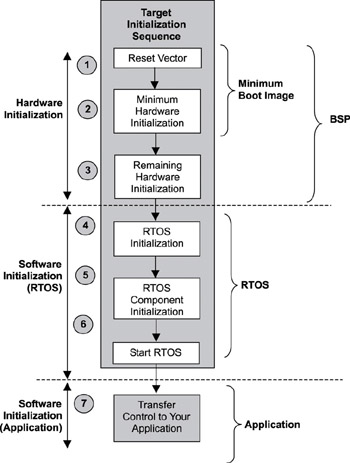Книга: Real-Time Concepts for Embedded Systems
3.4.1 Hardware Initialization
3.4.1 Hardware Initialization
The previous sections described aspects of steps 1 and 2 in Figure 3.7 in which a boot image executes after the CPU begins executing instructions from the reset vector. Typically at this stage, the minimum hardware initialization required to get the boot image to execute is performed, which includes:
1. starting execution at the reset vector
2. putting the processor into a known state by setting the appropriate registers:
? getting the processor type
? getting or setting the CPU’s clock speed
3. disabling interrupts and caches
4. initializing memory controller, memory chips, and cache units:
? getting the start addresses for memory
? getting the size of memory
? performing preliminary memory tests, if required

Figure 3.7: The software initialization process.
After the boot sequence initializes the CPU and memory, the boot sequence copies and decompresses, if necessary, the sections of code that need to run. It also copies and decompresses its data into RAM.
Most of the early initialization code is in low-level assembly language that is specific to the target system’s CPU architecture. Later-stage initialization code might be written in a higher-level programming language, such as C.
As the boot code executes, the code calls the appropriate functions to initialize other hardware components, if present, on the target system. Eventually, all devices on the target board are initialized (as shown in step 3 of Figure 3.7). These might include the following:
· setting up execution handlers;
· initializing interrupt handlers;
· initializing bus interfaces, such as VME, PCI, and USB; and
· initializing board peripherals such as serial, LAN, and SCSI.
Most embedded systems developers consider steps 1 and 2 in Figure 3.7 as the initial boot sequence, and steps 1 to 3 as the BSP initialization phase. Steps 1 to 3 are also called the hardware initialization stage.
Writing a BSP for a particular target system is not trivial. The developer must have a good understanding of the underlying hardware components. Along with understanding the target system’s block diagrams, data flow, memory map, and interrupt map, the developer must also know the assembly language for the target system’s microprocessor.
Developers can save a great deal of time and effort by using sample BSPs if they come with the target evaluation board or from the RTOS vendor. Typically, the microprocessor registers that a developer needs to program are listed in these BSPs, along with the sequence in which to work with them to properly initialize target-system hardware.
A completed BSP initialization phase has initialized all of the target-system hardware and has provided a set of function calls that upper layers of software (for example, the RTOS) can use to communicate with the hardware components of the target system.
- 3.4.2 RTOS Initialization
- 3.3. Hardware Platforms
- Initialization and association
- TV and Video Hardware
- Understanding init Scripts and the Final Stage of Initialization
- Choosing Backup Hardware and Media
- Hardware Requirements
- Meeting the Minimum Fedora Hardware Requirements
- Using Legacy Hardware
- Checking Hardware Compatibility
- Preparing for Potential Hardware Problems
- Preparing and Using a Hardware Inventory




